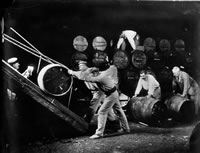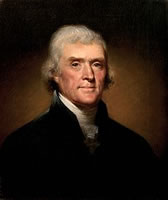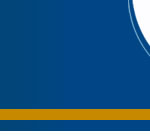 Although often referred to as boring and irrelevant, history, and especially the history of Barton & Guestier is passionate and rich. Almost three centuries of wines, labels, markets, people and passion. Share the start of B&G wines in the USA with us here! Although often referred to as boring and irrelevant, history, and especially the history of Barton & Guestier is passionate and rich. Almost three centuries of wines, labels, markets, people and passion. Share the start of B&G wines in the USA with us here!
The first barrels of "Barton’s wines" brought from Bordeaux to Baltimore by Daniel Guestier!
Like Thomas Barton, Daniel Guestier had a taste for travel. He probably inherited it from his grandfather, a former Royal Navy Officer. Daniel was captain of an ocean-going vessel, and ship-owner. He set up business in Baltimore, an ideal trading post for exporting Bordeaux wines from major wine merchants like Barton to America. Wines and many other goods, which the "insurrectionists" welcomed with open arms, when the American War of Independence broke out in 1775. Daniel Guestier, as the providential ally of young America, was to distinguish himself by successfully maintaining continuous supplies to the rebel states. To foil the English blockade obstructing the port of Bordeaux, he had some light, rapid boats specially built which outwit the Royal Navy by sailing from the Arcachon basin, Southwest of Bordeaux.
When peace was restored in 1783, Daniel had no trouble in continuing the wine trade. His father, François Guestier, had himself been a Bordeaux wine merchant since 1770. Prior to that, he was manager of the prestigious Châteaux Lafite and Latour, owned by the Marquis de Ségur, for whom he served as secretary from 1743 to 1765.
Although Barton and Guestier family members were working together for some thirty years already, the official foundation of Barton & Guestier took place in 1802 when Hugh Barton (Thomas’ grandson) and Daniel Guestier officially associate.
The quality of the wines
At the beginning of the 18th century, Bordeaux was merely a light "claret", pale in colour and low in alcoholic content, a "primeur" wine exported on the lees, that is to say unclarified. The wines described as "old" were those of the previous year and were less sought after than those of the current year. Over the generations, however, attitudes changed, under the influence of the Châteaux owners: the methods of trial and error and family recipes gradually gave way to more methodical techniques and the wine-growing aristocracy managed to produce what were, for the time, "great wines". The latter were better made than ordinary wines, being "sulphured", the grapes were sorted, a difference was made between the grape-juice from young and old vines, the techniques of clarifying and racking were gradually introduced. Of course, the maturing technique was still in its infancy. Above all, it was only used for vintage wines. If correctly vinified, wines of noble birth such as Margaux, Haut-Brion, Lafite, Latour and other Châteaux wines, which were already famous, could be cellared.
Thomas Jefferson
 Thomas Jefferson (1743-1826) served as America’s Minister to France between 1785 and the outbreak of the French Revolution, and developed a fascination for French wine. He visited France in 1787 and in a memorandum of the same year, the future President of the United States and a great connoisseur of Bordeaux, drew up a list of "vintage wines of the finest quality" and showed it to Daniel Guestier and Hugh Barton. Thomas Jefferson (1743-1826) served as America’s Minister to France between 1785 and the outbreak of the French Revolution, and developed a fascination for French wine. He visited France in 1787 and in a memorandum of the same year, the future President of the United States and a great connoisseur of Bordeaux, drew up a list of "vintage wines of the finest quality" and showed it to Daniel Guestier and Hugh Barton.
This selection closely resembled the famous 1855 classification, drawn up 68 years later..Upon his return to America, he continued to order large quantities of Bordeaux for himself and for George Washington. During his first term as President, Jefferson spent seventy-five hundred dollars and he is generally regarded as America’s first great wine connoisseur.
In the book: "The wines and travel of Thomas Jefferson" written by James M. Gabler, we learn:
“At the time of Jefferson's visit in 1787, Bordeaux was a big, rich city with about one third of of its export business in wine. The Gironde was crowded with ships and the city had air of opulence. Many of the foreign wine merchants were of English, Irish, German and Dutch heritage. These strangers had become wealthy and turned the Quai des Chartrons into one of the most exciting commercial and fashionable residential areas in the world, their mansions bordering the wide curving quays lined with elm trees. Although this area is still home to the wine trade, the elegant 18th century mansions now serve as offices and warehouses.
Jefferson recorded the principal Bordeaux English wine merchants as "Jernon, Barton, Johnston, Foster, Skinner, Copinger and Mac Cartey.... These Charton wine merchants had contracts with the great chateaux (such as Jernon and Feger with Château Margaux and Barton with Château Lafite) and controlled the supply and prices of the wines.
Althoug Jefferson's trip through the Bordeaux wine country was 68 years before the 1855 classification of the vineyards, his selection of Bordeaux's best Médocs and Sauternes was an extremely accurate projection of their later official rankings. He categorized only four vineyards of "first quality" Château Margaux, Latour , Lafite and Haut-Brion. Behind them he listed chateaux that we know today as Rausan-Ségla, and Léoville, which has since been divided into three vineyards: Léoville las Cases, Léoville Poyferré, and Léoville-Barton!
In the next issue of Assemblage we will learn more about how B&G wines were involved in the California Gold Rush!
|



